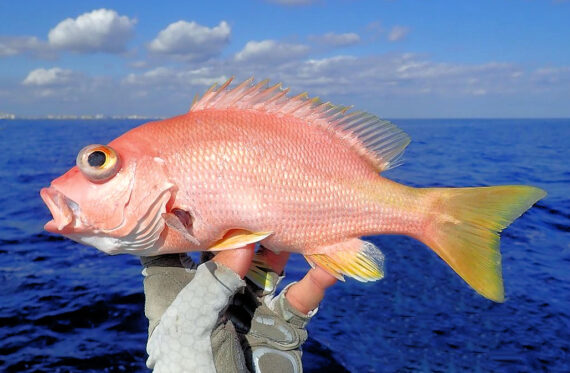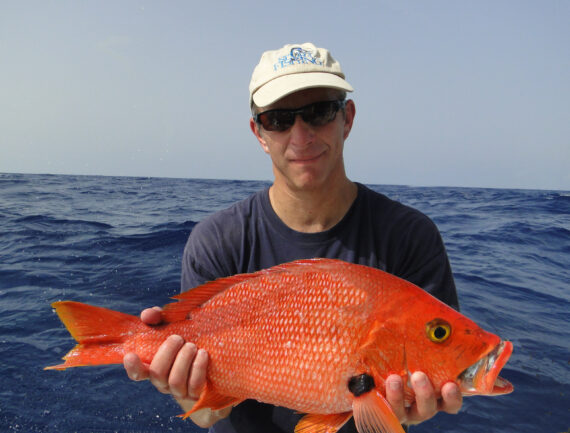Blackfin Snapper, Lutjanus buccanella
 Blackfin Snapper, Lutjanus buccanella. Fish caught from coastal waters off Deerfield Beach, Florida, December 2020. Length: 28 cm (11 inches). Catch, photograph and identification courtesy of Ben Cantrell, San Diego, California.
Blackfin Snapper, Lutjanus buccanella. Fish caught from coastal waters off Deerfield Beach, Florida, December 2020. Length: 28 cm (11 inches). Catch, photograph and identification courtesy of Ben Cantrell, San Diego, California.
 Blackfin Snapper, Lutjanus buccanella. Fish caught from waters off Pulley Ridge, 100 miles west of the Tortugas Ecological Reserve, Florida Keys, August 2019. Length: 43 cm (17 inches). Catch, photograph and identification courtesy of George Brinkman, Guelph, Ontario, Canada.
Blackfin Snapper, Lutjanus buccanella. Fish caught from waters off Pulley Ridge, 100 miles west of the Tortugas Ecological Reserve, Florida Keys, August 2019. Length: 43 cm (17 inches). Catch, photograph and identification courtesy of George Brinkman, Guelph, Ontario, Canada.
 Blackfin Snapper, Lutjanus buccanella. Fish caught from waters off Pulley Ridge, 100 miles west of the Tortugas Ecological Reserve, Florida Keys, November 2018. Length: 46 cm (18 inches). Catch, photograph and identification courtesy of George Brinkman, Guelph, Ontario, Canada.
Blackfin Snapper, Lutjanus buccanella. Fish caught from waters off Pulley Ridge, 100 miles west of the Tortugas Ecological Reserve, Florida Keys, November 2018. Length: 46 cm (18 inches). Catch, photograph and identification courtesy of George Brinkman, Guelph, Ontario, Canada.
 Blackfin Snapper, Lutjanus buccanella. Fish caught from coastal waters off Cancun, Quintano Roo, August 2013 Length: 79 cm (31 inches). Catch, photograph and identification courtesy of Dominick Porcelli, Lighthouse Point, Florida.
Blackfin Snapper, Lutjanus buccanella. Fish caught from coastal waters off Cancun, Quintano Roo, August 2013 Length: 79 cm (31 inches). Catch, photograph and identification courtesy of Dominick Porcelli, Lighthouse Point, Florida.
The Blackfin Snapper, Lutjanus buccanella, is a member of the Snapper or Lutjanidae Family, and is known in Mexico as buccanella sesi. Globally, there are sixty-seven species in the genus Lutjanus, of which nineteen are found in Mexican waters, ten in the Atlantic and nine in the Pacific Ocean.
The Blackfin Snapper has a relative deep compressed body and a relatively large mouth with a moderately protrusible top jaw equipped with 1 or more rows of pointed conical teeth and some canines. They have a scarlet to orange colored head and body dorsally that transitions to silvery ventrally. The iris of their eye is yellow to orange and they have a pronounced black spot on the base of the pectoral fin. Their fins are yellowish to orange. Sub-adults are red with yellow caudal and pelvic fins; juveniles are cream color with yellow caudal fins. The anal fin has 3 spines and 8 rays and is rounded; their caudal fin is slightly concave; their dorsal fin has 10 spines and 14 rays and is continuous; and, their pectoral fins have 16 to 18 rays. They have 17 to 19 lower gill rakers. They are covered with scales with oblique scale rows above their lateral line.
The Blackfin Snapper is a reef-associated species, that are found at depths greater than 60 m (200 feet) over sandy or rocky bottoms and near drop-off and ledges. Juveniles are found in shallower water at depths between 30 m (100 feet) and 53 m (175 feet). They reach a maximum 75 cm (2 feet 6 inches) in length of 14 kg (31 lbs) in weight. As of January 1, 2024, the International Game Fish Association world record stood at 4.00 kg (8 lbs 13 oz) with the fish caught in coastal waters off Cypremont Port, Louisiana, July 2023. They feed primarily on fishes and benthic isopods. They have life spans of twenty years. The Blackfin Snapper is poorly studied with very limited information available about their lifestyle and behavioral patterns including specific details on age, growth, longevity, movement patterns, diet, habitat use, and reproduction.
The Blackfin Snapper is a resident of Mexican waters of the Atlantic Ocean and are found in coastal waters if the eastern Gulf of Mexico, being more abundant in deep water environments within the coastal waters of Veracruz, and along the east coast of the Yucatán Peninsula in the Caribbean.
The Blackfin Snapper is most likely confused with the Schoolmaster, Lutjanus apodus (yellowish brown with a yellow-blue line along the cheek).
From a conservation perspective the Blackfin Snapper is currently considered to be Data Deficient. They are, however, widely distributed in deep water but subject to heavy commercial fishing pressure. They are protected is some parts of their deeper water habitats via permits, size limits and gear restrictions. They are considered to be an important component of the multispecies deep-water commercial snapper fishery that are caught with hand lines, long-lines and traps and harvested at a level of 1 to 10 tons per annually of which Mexican catch levels are nominal. They are known to possess ciguatoxin.